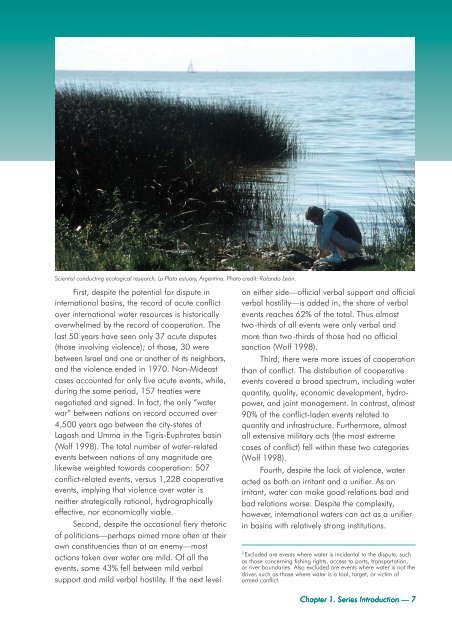Latin America; in English (pdf) - Transboundary Freshwater Dispute ...
Latin America; in English (pdf) - Transboundary Freshwater Dispute ...
Latin America; in English (pdf) - Transboundary Freshwater Dispute ...
Create successful ePaper yourself
Turn your PDF publications into a flip-book with our unique Google optimized e-Paper software.
Scientist conduct<strong>in</strong>g ecological research, La Plata estuary, Argent<strong>in</strong>a. Photo credit: Rolando León.<br />
First, despite the potential for dispute <strong>in</strong><br />
<strong>in</strong>ternational bas<strong>in</strong>s, the record of acute conflict<br />
over <strong>in</strong>ternational water resources is historically<br />
overwhelmed by the record of cooperation. The<br />
last 50 years have seen only 37 acute disputes<br />
(those <strong>in</strong>volv<strong>in</strong>g violence); of those, 30 were<br />
between Israel and one or another of its neighbors,<br />
and the violence ended <strong>in</strong> 1970. Non-Mideast<br />
cases accounted for only five acute events, while,<br />
dur<strong>in</strong>g the same period, 157 treaties were<br />
negotiated and signed. In fact, the only “water<br />
war” between nations on record occurred over<br />
4,500 years ago between the city-states of<br />
Lagash and Umma <strong>in</strong> the Tigris-Euphrates bas<strong>in</strong><br />
(Wolf 1998). The total number of water-related<br />
events between nations of any magnitude are<br />
likewise weighted towards cooperation: 507<br />
conflict-related events, versus 1,228 cooperative<br />
events, imply<strong>in</strong>g that violence over water is<br />
neither strategically rational, hydrographically<br />
effective, nor economically viable.<br />
Second, despite the occasional fiery rhetoric<br />
of politicians—perhaps aimed more often at their<br />
own constituencies than at an enemy—most<br />
actions taken over water are mild. Of all the<br />
events, some 43% fell between mild verbal<br />
support and mild verbal hostility. If the next level<br />
on either side—official verbal support and official<br />
verbal hostility—is added <strong>in</strong>, the share of verbal<br />
events reaches 62% of the total. Thus almost<br />
two-thirds of all events were only verbal and<br />
more than two-thirds of those had no official<br />
sanction (Wolf 1998).<br />
Third, there were more issues of cooperation<br />
than of conflict. The distribution of cooperative<br />
events covered a broad spectrum, <strong>in</strong>clud<strong>in</strong>g water<br />
quantity, quality, economic development, hydropower,<br />
and jo<strong>in</strong>t management. In contrast, almost<br />
90% of the conflict-laden events related to<br />
quantity and <strong>in</strong>frastructure. Furthermore, almost<br />
all extensive military acts (the most extreme<br />
cases of conflict) fell with<strong>in</strong> these two categories<br />
(Wolf 1998).<br />
Fourth, despite the lack of violence, water<br />
acted as both an irritant and a unifier. As an<br />
irritant, water can make good relations bad and<br />
bad relations worse. Despite the complexity,<br />
however, <strong>in</strong>ternational waters can act as a unifier<br />
<strong>in</strong> bas<strong>in</strong>s with relatively strong <strong>in</strong>stitutions.<br />
2<br />
Excluded are events where water is <strong>in</strong>cidental to the dispute, such<br />
as those concern<strong>in</strong>g fish<strong>in</strong>g rights, access to ports, transportation,<br />
or river boundaries. Also excluded are events where water is not the<br />
driver, such as those where water is a tool, target, or victim of<br />
armed conflict.<br />
Chapter 1. Series Introduction — 7
















